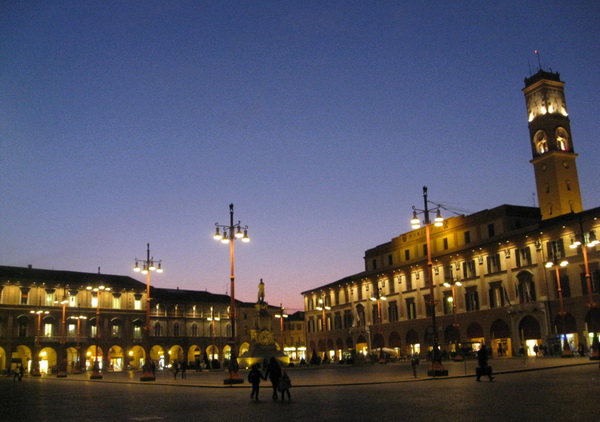Ancient era
The surroundings of Forlì have been inhabited since the Paleolithic: a site, Ca' Belvedere of Monte Poggiolo, has revealed thousands of chipped flints in strata dated 800,000 years before the present era, which indicates a flint-knapping industry producing sharp-edged tools in a pre-Acheulean phase of the Paleolithic.
Forlì was founded after the Roman conquest of the remaining Gallic villages, about the time the Via Aemilia was built. With no clear evidence, the exact date this occurred is still under debate, though some historians believe that the first settlement of the ancient Roman Forum was built in approximately 188 BC by consul Gaius Livius Salinator (who fought Hasdrubal Barca and vanquished him at the banks of the Metaurus River in 207 BC). Others argue it may have been founded later, during the time of Julius Caesar. In 88 BC, the city was destroyed during the civil wars of Gaius Marius and Sulla, but later rebuilt by the praetor Livius Clodius.
Middle Ages
After the collapse of the Western Roman Empire, the city was incorporated into the realms of Odoacer and of the Ostrogoth kingdom. From the end of the 6th century to 751, Forlì was an outlying part of the Byzantine power in Italy known as the Exarchate of Ravenna. During this time the Germanic Lombards repeatedly took the city – in 665, 728, and 742. It was finally incorporated with the Papal States in 757, as part of the Donation of Pepin.
By the 9th century the commune had taken control from its bishops, and Forlì was established as an independent Italian city-state, alongside the other communes that signalled the first revival of urban life in Italy. Forlì became a republic for the first time in 889. At this time the city was allied with the Ghibelline factions in the medieval struggles between the Guelphs and Ghibellines, partly as a means of preserving its independence – and the city supported all the Holy Roman Emperors in their campaigns in Italy.
Local competition was involved in the loyalties: in 1241, during Frederick II's struggles with Pope Gregory IX the people of Forlì offered their support to Frederick II during the capture of the rival city, Faenza, and in gratitude, they were granted an addition to their coat-of-arms -the Hohenstaufen eagle.
With the collapse of Hohenstaufen power in 1257, imperial lieutenant Guido I da Montefeltro was forced to take refuge in Forlì, the only remaining Ghibelline stronghold in Italy. He accepted the position of capitano del popolo ("Captain of the People") and led Forlì to notable victories: against the Bolognesi at the Ponte di San Proculo, on 15 June 1275; against a Guelph allied force, including Florentine troops, at Civitella on 14 November 1276; and at Forlì itself against a powerful French contingent sent by Pope Martin IV, on 15 May 1282, in a battle cited by Dante Alighieri (who was hosted in the city in 1303 by Scarpetta Ordelaffi III), Inferno 27. In 1282, Forlì's forces were led by Guido da Montefeltro. The astrologer Guido Bonatti (advisor of Emperor Frederick II, too) was one of his advisors.
The following year the city's exhausted Senate was forced to cede to papal power and asked Guido to take his leave. The commune soon submitted to a local condottiere rather than accept a representative of direct papal control, and Simone Mestaguerra had himself proclaimed Lord of Forlì. He did not succeed in leaving the new signory peacefully to an heir, however, and Forlì passed to Maghinardo Pagano, then to Uguccione della Faggiuola (1297), and to others, until in 1302 the Ordelaffi came into power.
Local factions with papal support ousted the family in 1327–29 and again in 1359–75, and at other turns of events the bishops were expelled by the Ordelaffi. Until the Renaissance the Ordelaffi strived to maintain the possession of the city and its countryside, especially against Papal attempts to assert back their authority. Often civil wars between members of the family occurred. They also fought as condottieri for other states to earn themselves money to protect or embellish Forlì.

No comments:
Post a Comment